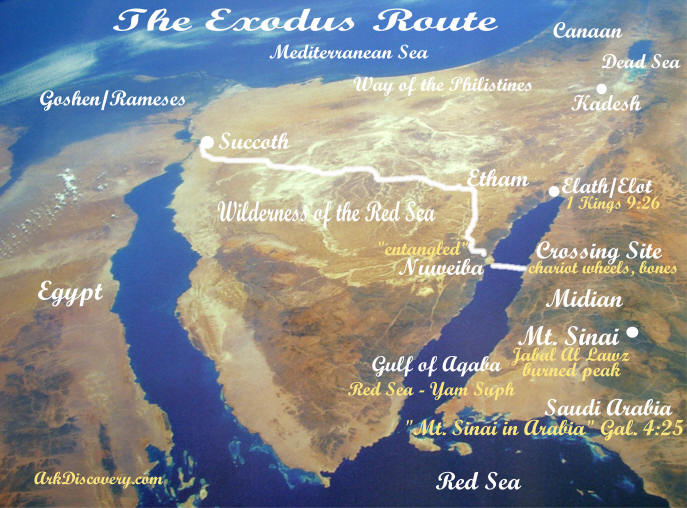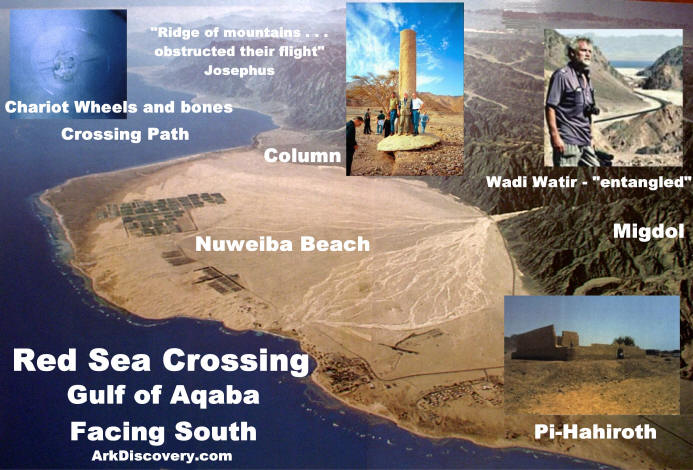The Red Sea Crossing
The Traditional Site
There is a traditional route of the Exodus which has the children of Israel wading in shallow water through an area north of the Gulf of Suez while the tide was out. This area cannot be the crossing site as it does not match the biblical account. A shallow area of water could not drown all of the Egyptian army. Also, they were to leave Egypt proper before encountering the Red Sea crossing. After crossing the Red Sea, the Bible says they encountered the mountain of God or Mount Sinai which is in Midian. Midian is not in the area we call today the Sinai Peninsula. It is instead in Saudi Arabia and can be found on most maps in that location. The traditional Mt. Sinai was "found" by Constantine's "psychic" mother who in the fourth century went around the Holy Land pointing out various sites as the "authentic" biblical sites, such as the birthplace of Christ, the church of the Holy sepulcher (which was a pagan temple during her time), etc. There is no archaeological evidence of the forty year existence of the children of Israel in the Sinai Peninsula.
The Majority of Archaeologists
The majority of archaeologists today do not have enough faith in the Bible as the accurate word of God. The majority of archaeologists do not even believe in the exodus of the children of Israel from Egypt, according to Hershel Shanks, editor of the Biblical Archaeology Review magazine. They are skeptical of the biblical account, perhaps because of a lack of archaeological evidence in the Sinai Peninsula and a lack of faith. We cannot look to these men to tell us where or if the exodus took place.
The Red Sea Crossing Site Found by Ron Wyatt
The children of Israel lived in the Nile delta area or the land of Rameses, and first encamped at the northern end of the Gulf of Suez or Succoth at the beginning of the Exodus. This was the first point where they went into the camping mode. Then they traveled through the wilderness of the Red Sea, or what we

call today the Sinai Peninsula, and encountered the Gulf of Aqaba. (I Kings 9:26 calls this the Red Sea.)
The Wilderness Has Them Entangled
Wadi Watir had the Children of Israel "entangled." Exit point at the large beach at Nuweiba (2005)
When traveling through "the wilderness of the Red Sea" Ex.13:18, escaping Pharaoh's army, God told Moses to turn south, so they headed through a wadi or canyon area that is called the Wadi Watir which led to the sea. The Bible in Ex. 14:3 says, "They are entangled in the land, the wilderness hath shut them in."
Above, the Wadi Watir winding its way to the Red Sea Crossing site at Nuweiba, had the children of Israel
thinking Moses had made a wrong decision to bring them this way.
The Beach Where the Crossing Took Place
When arriving at the beach, the children of Israel felt trapped, as they could not turn back, nor head north because at the northern end of the beach was a three story, Egyptian military fortress which is still standing today undergoing restoration.
Egyptian military fortress, possibly Migdol, blocked any northern escape route (photo 2005)
Additionally there were mountains obstructing their escape. To the south the mountains came down to the sea, as mentioned by Josephus, "For there was [on each side] a [ridge of] mountains that terminated at the sea, which were impassable by reason of their roughness, and obstructed their flight" Antiquities of the Jews, Bk. 2, 15-3. You can see the mountains at the beach today. The people were about to turn against Moses because he had led them to an area where they were trapped and would surely die, or so they thought.

(Aerial Photo 1982 National Geographic)
If one looks on a map for a beach area large enough for 2 million people to encamp on the gulf there is only one candidate: Nuweiba Egypt. The beach at Nuweiba is extremely large and could have accommodated a large number of people at the time of Moses. Today you will find many hotels there and a village.
The Granite Column of Solomon
This column matches one on the other side of the gulf in Saudi Arabia which had the inscriptions intact. The Hebrew words Egypt, death, water, pharaoh, Edom, Yahweh, and Solomon were on that column. Apparently one can conclude
Kevin Fisher at the red granite column, marking the crossing site (Oct. 2005)
King Solomon had these columns erected 400 years after the miracle of the crossing of the Red Sea on dry land. Solomon's sea port was at the northern tip of the Gulf of Aqaba at Eilat (I Kings 9:26) and he was very familiar with the Red Sea crossing site, as it was in his neighborhood. The Bible even mentions this column! Isaiah 19:19, "In that day there will be an altar to the Lord in the midst of the land of Egypt, and a pillar to the Lord at its border." You can visit the beach today and see the column in person, as I was able to do in Oct. 2005.
Gradual Contour of Seabed
God caused a strong east wind to blow the waters back so the people could walk ten miles through the Red Sea to safety in Arabia. The crossing path is about a quarter to a half mile wide and is on a gradual slope down

No comments:
Post a Comment